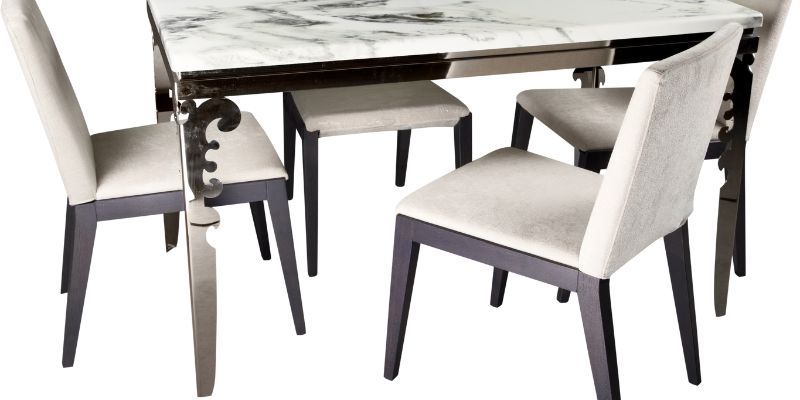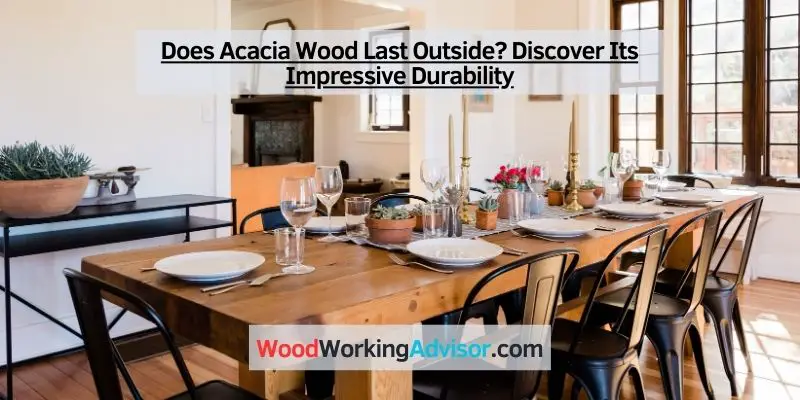Yes, Acacia wood is a durable material that can withstand outdoor conditions for a considerable amount of time. Acacia wood is known for its resistance to rotting, insect infestation, and decay, making it suitable for outdoor uses such as furniture, decking, and patio accessories.
Its natural oils and dense grain structure contribute to its longevity, allowing it to withstand exposure to moisture and harsh weather conditions. Additionally, Acacia wood requires minimal maintenance to keep its appearance and durability intact. With proper care and occasional sealing, Acacia wood can last outside for many years, providing an attractive and functional outdoor solution.
Pros And Cons Of Acacia Wood
When it comes to selecting outdoor furniture or decking material, you want something that not only looks great but also stands the test of time. Acacia wood is a popular choice for outdoor use due to its natural durability and aesthetic appeal. However, like any other material, it has its own set of advantages and disadvantages. In this section, we will explore the pros and cons of using acacia wood for outdoor applications.
Advantages Of Acacia Wood
Acacia wood offers several advantages that make it an excellent choice for outdoor furniture or decking. Let’s take a closer look at some of its noteworthy benefits:
- Durability: One of the primary advantages of acacia wood is its exceptional durability. It is known for its resistance to water damage, rot, and insect infestation, making it well-suited for outdoor use. This makes acacia wood an excellent long-term investment for your outdoor space.
- Natural Beauty: Acacia wood is prized for its natural beauty. It features a rich, warm color with unique grain variations that add character to any space. Whether you prefer a rustic or contemporary look, acacia wood can effortlessly complement your outdoor décor.
- Eco-Friendly: If sustainability is a priority for you, acacia wood is an environmentally-friendly choice. It is sourced from fast-growing acacia trees, which can be harvested within a relatively short period. This means that choosing acacia wood helps to conserve other slow-growing hardwood species.
- Cost-Effective: Compared to some other hardwood options, acacia wood is relatively more affordable. Despite its affordability, it still offers the durability and beauty that you would expect from a high-quality material. This makes acacia wood a cost-effective solution for your outdoor furniture or decking needs.
Disadvantages Of Acacia Wood
While acacia wood has many advantages, it is essential to consider its potential drawbacks before making your final decision:
- Prone to Scratches: Acacia wood, like most hardwoods, is prone to scratching. However, you can mitigate this by using protective coatings or regular maintenance practices such as applying sealants or oils to keep the wood looking its best. These precautions will help minimize the appearance of scratches over time.
- High Maintenance: Acacia wood requires regular maintenance to keep it in optimal condition. It is recommended to clean the wood regularly and reapply protective coatings to protect it from the elements. Failure to perform routine maintenance can lead to weathering, discoloration, or even warping.
- Variability in Quality: Another potential drawback of acacia wood is the variability in quality from different sources. Not all acacia wood is created equal, so it is crucial to ensure you purchase from reputable sellers or manufacturers who guarantee high-quality wood. This will help you avoid any potential issues and ensure the longevity of your outdoor furniture or decking.

Factors Affecting Acacia Wood’s Outdoor Durability
Acacia wood is a popular choice for outdoor furniture and decking due to its sturdy nature and natural beauty. However, its durability can vary depending on several factors. Understanding these factors can help you make an informed decision about whether acacia wood is a suitable choice for your outdoor projects.
Natural Resistance To Decay
One of the key factors affecting the outdoor durability of acacia wood is its natural resistance to decay. Acacia wood contains natural oils and resins that act as a defense mechanism against insects, fungi, and rot. These natural properties make acacia wood highly resistant to decay, ensuring that it can withstand the rigors of outdoor use for an extended period.
Moisture Exposure
Moisture exposure plays a crucial role in determining the outdoor durability of acacia wood. While acacia wood has natural resistance to decay, prolonged exposure to moisture can still lead to issues such as warping, splitting, and mold growth. To ensure the longevity of acacia wood outdoors, it is essential to protect it from excessive moisture. Applying a protective sealant or finish can help create a barrier against water penetration and reduce the risk of damage caused by moisture.
Uv Rays And Sunlight
Acacia wood is also exposed to the effects of UV rays and sunlight when used outdoors. Over time, prolonged exposure to sunlight can cause the wood to fade, lose its natural color, and develop a weathered appearance. The sun’s rays can also lead to the drying out of the wood, making it more prone to cracking and splitting. To mitigate these effects, it is recommended to apply a UV-resistant finish or periodically reapply protective coatings to maintain the wood’s natural beauty and prevent sun damage.
Temperature And Weather Conditions
Temperature variations and extreme weather conditions can impact the durability of acacia wood outdoors. Fluctuations in temperature, especially freezing temperatures, can cause the wood to contract and expand, leading to cracks and structural damage. Extreme heat can also cause the wood to dry out and lose its moisture content, making it more susceptible to decay and degradation. To ensure the longevity of acacia wood outdoors, it is advisable to provide proper protection by using covers or storing the furniture during extreme weather conditions.
How To Enhance The Durability Of Acacia Wood Outdoors
Acacia wood is a popular choice for outdoor furniture and other outdoor applications due to its natural durability. However, if you want to ensure that your acacia wood lasts for years to come, it’s essential to take some additional measures. By following these tips, you can enhance the durability of your acacia wood outdoors, keeping it looking beautiful and functional for an extended period.
Sealing And Protective Coatings
One of the most effective ways to enhance the durability of acacia wood outdoors is by applying sealants and protective coatings. These products create a barrier between the wood surface and external elements, such as moisture, UV rays, and pests. By sealing the wood, you can prevent water absorption, which can lead to warping, splitting, and cracking of the wood over time.
There are various sealants and protective coatings available in the market, each offering different levels of protection. Before applying any product, make sure to clean the wood surface thoroughly and let it dry completely. Follow the manufacturer’s instructions regarding application methods and drying times. Remember to apply the sealant or coating evenly and cover all exposed surfaces, including the edges and undersides of furniture.
Regular Cleaning And Maintenance
To keep your acacia wood looking its best and increase its lifespan, regular cleaning and maintenance are crucial. Since outdoor furniture is exposed to dust, dirt, pollen, and other debris, it’s necessary to clean the wood surface periodically. Use a mild soap or specialized wood cleaner and warm water to remove dirt and grime. Avoid harsh chemicals or abrasive cleaners that can damage the wood’s natural surface.
After cleaning, rinse the wood thoroughly and allow it to dry completely before using the furniture again. This helps prevent the accumulation of moisture, which can contribute to the growth of mold and mildew. Additionally, consider using a wood preservative or oil-based conditioner to nourish the wood and restore its natural oils, helping to maintain its strength and appearance.
Avoiding Direct Ground Contact
Direct ground contact can significantly reduce the lifespan of acacia wood outdoors. When wood is in direct contact with the ground, it can absorb moisture from the soil, leading to decay and rot over time. To avoid this, it’s essential to elevate your acacia wood furniture or use a proper base.
One option is to place your furniture on a well-drained surface, such as a patio or deck. If you’re placing acacia wood directly on the ground, consider using concrete blocks or wooden spacers between the ground and the furniture legs. This provides the necessary airflow and prevents moisture from building up underneath the wood.
By following these guidelines for enhancing the durability of acacia wood outdoors, you can extend the lifespan of your furniture and keep it looking and functioning at its best. Regular maintenance, protective coatings, and proper elevation will ensure that your acacia wood remains a beautiful and long-lasting addition to your outdoor space.

Acacia Wood Vs Other Popular Outdoor Wood Types
When it comes to choosing the right wood for your outdoor furniture or decking, durability and resistance to the elements are key. Acacia wood has become a popular choice for outdoor use due to its impressive strength and natural beauty. In this article, we will compare acacia wood with other popular outdoor wood types such as cedar wood, teak wood, and eucalyptus wood, helping you make an informed decision for your outdoor space.
Comparison With Cedar Wood
Cedarwood is often praised for its natural resistance to rot and insects, making it a popular choice for outdoor projects. However, when compared to acacia wood, cedar falls short in terms of durability. While cedar wood can last 15-20 years when properly maintained, acacia wood has a lifespan of 20-25 years, making it the superior choice for long-lasting outdoor furniture and decking.
Comparison With Teak Wood
Teak wood is known for its exceptional resistance to weathering and decay, making it highly popular for outdoor use. However, it comes with a hefty price tag. Acacia wood, on the other hand, offers a more affordable alternative without compromising on quality. While teak wood can last up to 50 years or more, acacia wood’s lifespan of 20-25 years still makes it a viable option, especially considering the cost savings.
Comparison With Eucalyptus Wood
Eucalyptus wood shares many similarities with acacia wood in terms of strength and durability. Both kinds of wood are resistant to rot and decay, making them ideal for outdoor applications. However, acacia wood surpasses eucalyptus in terms of hardness, making it more resistant to dents and scratches. Additionally, acacia wood boasts a more attractive grain pattern, enhancing the aesthetic appeal of your outdoor space.
Frequently Asked Questions For Does Acacia Wood Last Outside
What Are The Disadvantages Of Acacia Wood?
The disadvantages of acacia wood include susceptibility to scratches, dents, and warping. It can also be prone to mold if not properly maintained. Additionally, acacia wood may darken or change color over time, and it is not recommended for outdoor use due to its sensitivity to extreme weather conditions.
Overall, it requires regular maintenance and care.
How Well Does Acacia Wood Hold Up Outside?
Acacia wood holds up well outside due to its natural durability and resistance to decay and rot. It is also resistant to various outdoor conditions, such as moisture, insects, and excessive heat. Its strength and density make it ideal for outdoor furniture, decking, and other outdoor applications.
How Do You Protect Acacia Wood Outside?
To protect acacia wood outside, follow these steps:
1. Clean the surface with mild soapy water and a soft brush.
2. Apply a protective finish or sealant specifically made for outdoor use.
3. Use a brush or roller to evenly apply the sealant.
4. Allow the sealant to dry completely.
5. Repeat the process every year to maintain protection against the elements.
Can Acacia Wood Be Left Outside In Snow?
Yes, acacia wood can be left outside in snow. It is durable and resistant to moisture, but proper maintenance is important to prevent damage. Regular cleaning and applying a protective finish can help maintain the wood’s quality when exposed to snow.
Conclusion
To summarize, Acacia wood is a durable and long-lasting option for outdoor use. Its natural oils and dense grain make it resistant to rotting, decay, and insect infestations. Proper maintenance, such as regular cleaning and oiling, can extend its lifespan even further.
Whether you’re considering Acacia wood for furniture, decking, or other outdoor projects, rest assured that it will stand the test of time, adding beauty and functionality to your outdoor space for years to come.



One thought on “Does Acacia Wood Last Outside? Discover Its Impressive Durability”